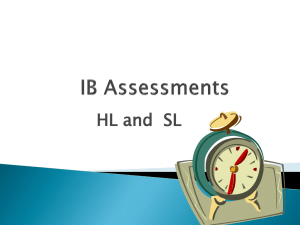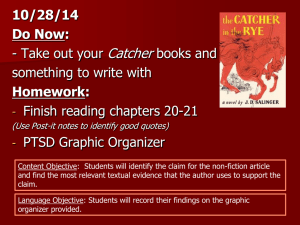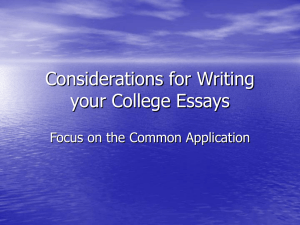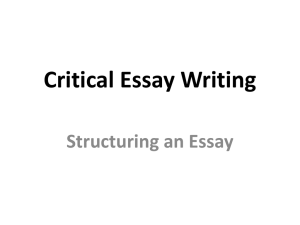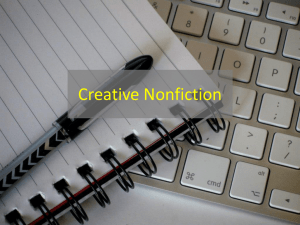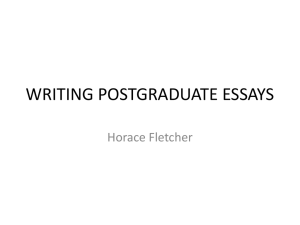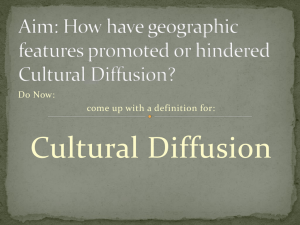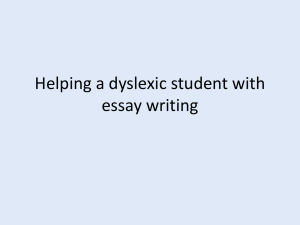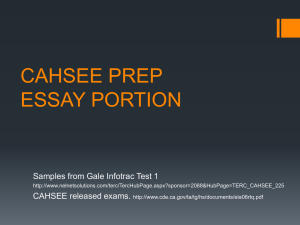Essay writing SENIOR
advertisement
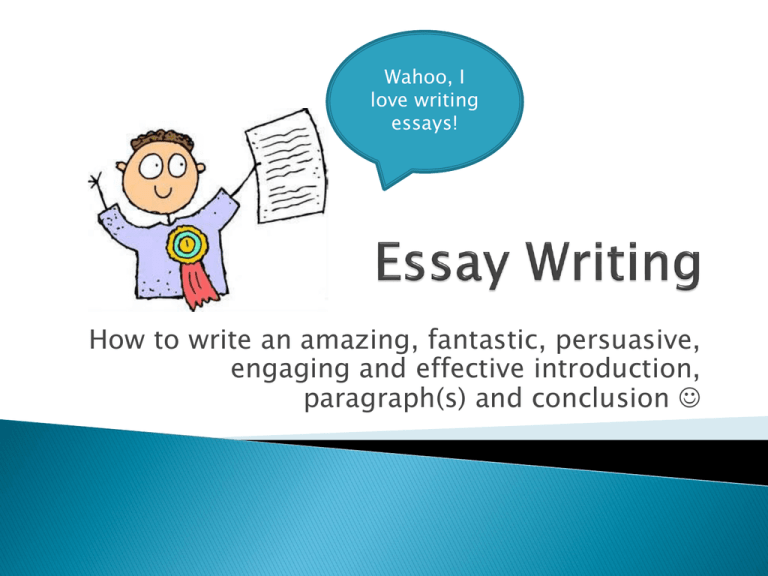
Wahoo, I love writing essays! How to write an amazing, fantastic, persuasive, engaging and effective introduction, paragraph(s) and conclusion An ESSAY is an ARGUMENT An essay is an argument because the purpose of an essay is to take position on a question, and then argue your viewpoint based on evidence. Planning is a vital step to writing an effective essay. Writing a plan will help you! a) write more logically b) write more coherently c) write faster – you will get more done in less time. Often you are given an essay topic, and you end up sitting there wondering what on earth you are going to write about: either you have too many possible ideas; or you might be sitting there thinking: ‘I don’t know the first thing to say in this essay – I’ll never complete it!’. Write down all the possible ideas you have for the essay/topic Next, highlight the 3 best ideas for the particular topic. These 3 ideas become your 3 main paragraphs, find some evidence and quotes to back them up, and away you go! It is always better to focus on 3 main ideas and expand on these (give analysis & depth) rather than present 15 ideas in less depth. Think about the ORDER of your 3 main points: what is the most effective way to order these ideas in order to develop your argument best? It is often a good idea to lead into the strongest point and keep the reader wanting to know more until the final paragraph! Remember: being a great writer is not about having all sorts of imaginative adjectives and witty language. The goal of great writing is CLARITY CLARITY is better than CLEVERNESS because it will be more effective at ARGUING your point! TAKO TEXAS LATE WE LOVE ACRONYMS!!!! Aside from a delicious treat, in English, TAKO stands for: T Title (must be underlined!) A Author K Key Words O Outline of the main points you will provide in your essay If you remember TAKO, you will always know what to write in your awesome introduction! An effective introduction will tell the reader precisely what your essay is going to be about, and the main point/argument that you are making. It doesn’t matter what you intend to argue in your essay, what matters is that you make it absolutely clear to the reader in the first paragraph what your argument is. There are FOUR basic steps to writing a simple but effective introduction. These are: ◦ Sentence one: A neutral sentence. For example “Khaled Hosseini’s first novel The Kite Runner is rife with key messages and themes. This commences the essay in an informative way. ◦ Sentence two: Context sentence. Give us a bit more detail/introduce your topic/novel. For example: The novel is set in both Afghanistan and America and is thus underscored with the historical and political issues prominent in these countries. ◦ Sentence three: State the argument/your thesis statement. We will discuss this in more detail soon... ◦ Sentence four: Sum up. This reinforces the main point you will be discussing in the essay. A thesis statement: tells the reader how you interpret the question/subject is a road map for the paper; in other words, it tells the reader what to expect from the rest of the paper. directly answers the question asked of you and clearly states your argument. is usually a single sentence (2 max) somewhere in your first paragraph that presents your argument to the reader. The rest of the paper, the body of the essay, gathers and organizes evidence that will persuade the reader of the logic of your interpretation. If your assignment asks you to take a position or develop a claim about a subject, you may need to convey that position in the statement. The thesis statement tells the reader your purpose in writing the essay. Thesis statements do not use ‘I’, ‘my’, etc – although they are your opinions/ideas, use third person for a stronger, more confident approach FORMAT: Write your topic (the question), write your opinion about it (what are you arguing), write three reasons/examples (how does the text show this). These reasons will become the focus paragraphs of your essay. Example question: - Who is the true father figure for Amir in The Kite Runner? Rahim Khan was Amir’s true father figure, shown in the novel by Baba’s hostility towards his son, his tendency to seek fatherhood advice from Rahim, and through Rahim’s influence over the major events of Amir’s life. This immediately addresses the characterisation of Baba, significant events, and the theme of father/son relationships. A second sentence could strengthen this further: Since the novel is a bildungsroman, Rahim’s position as the true father figure shows that...... Don’t fall into the trap of writing a thesis statement without an ARGUMENT E.g. Don’t just describe the process “In this essay I will discuss the presentation of the father figure”.... You need to start straight away with your POSITION and what you are ARGUING. If your introduction does not state your opinion and argument, there is no point continuing yet! TEXAS is an acronym for the key components of a paragraph. TEXAS is a logical way to organise your thoughts and ideas in a paragraph, so that you can get your ARGUMENT across to the reader in a PERSUASIVE way. It doesn’t matter how good your ideas are, if you can’t structure them correctly, the reader won’t get it! T: Topic sentence (Your main idea) E: Explanation and elaboration (Add more information to your central idea) X: eXample(s) and evidence (Back up what you are saying with evidence or examples A: Analysis (This shows that….) – tell the reader what you have learnt/what your argument means S: Summary (Therefore….) Sum up your argument. As your writing becomes more sophisticated, you can add more examples and analysis to your paragraphs. TEXaXaXaXaS (remember, you need at least 3 amazing examples for Excellence grades in NCEA!) A topic sentence tells the reader what your paragraph is ABOUT. This includes WHO, WHAT, WHY, WHEN, WHERE. The topic sentence states the TOPIC or SUBJECT of the sentence; a short, one sentence introduction. Remember you only present ONE idea per paragraph This gives further details about your topic sentence. Explain it in more DEPTH The explanation should be 2-3 sentences long. The examples and proof for the idea that you have outlined in your topic sentence/explanation. The examples need to SUPPORT the point that you are making. You might quote/reference a text, quote the opinion of an expert, use statistics and data, etc. We could talk about this as “And Shows…” You need to state why the example is relevant to the topic – e.g. what are the consequences? What does this make you think about? What have you learnt? What ideas/issues does this raise? A good way to structure this part is to say “This show that…….. because………..” Or, “from this the reader can understand that…….. because ………… TOPIC SENTENCE EXPLANATION EXAMPLES/EVIDENCE ANALYSIS SUMMARY Let’s write one as a class based on Birkenhead College... Birkenhead college is a small school, but a great school. There are only 750 students, so everyone knows each other. There are only 5 blocks that make up the college. Despite its small size, it has great academic success. As Mr. Mathewson states “where everybody is somebody”. This quote is of particular reference to Ms. Eichstaedt’s Y12 English class who will have straight excellences in English this year. This shows that Birkenhead College is small but effective. It’s the end of the essay, you just need to write an amazing conclusion…. An easy way to remember the key components of an amazing conclusion, is LATE Some people find it challenging to write a conclusion. They think: “I’ve said everything that I want to say in the essay – what on earth am I going to say in the conclusion!?” Conclusions are your opportunity to drive home the points that you are trying to make across your whole essay and drive these home. Importantly, they are a good place to add strong, thoughtful comments L = link to question/key words identified in introduction. You need to prove that you have answered/addressed the question. Restate your argument here! A = Author’s purpose. Why did the author write this book? What does the key ideas in your essay show about their purpose? What were they trying to make the reader think about? This is your thoughtful analysis! T = Topic/theme = You need to connect the topic of your essay to a major theme. E = End well! End your essay in a way that is memorable. It could be a quote, an opinion, a thought-provoking statement, a rhetorical question, etc… Give the reader something to ponder! Felix, in Once is an interesting character because he demonstrates the theme, his outlook changes from naïve to perceptive and he provides the narrative voice. Morris Gleitzman uses Felix to make the reader think of the negative effects of war on society. Because of war, Bruno lost his family and friends, and this tragedy is summed up in Alfred Adler’s words: “war is organised murder and torture against our brothers”. To gain Merit and Excellence grades, your writing will need to demonstrate ORIGINALITY and ideas BEYOND THE TEXT (i.e. discussing personal insight and observations) - what has the text taught you about your own life/society? - what was the writer’s purpose? - how do the themes in the text help you understand your world? This is why ‘ANALYSIS’ is so important to TEXAS. In a written text response, you need to demonstrate your awareness that the text was CRAFTED. Where possible, discuss literary techniques, author’s purpose, etc. You must show a strong awareness of the reader-writer relationship Analyse – don’t just describe! Always explain WHY something was used or WHAT IT SHOWS/EXPLAINS Be Specific – For example, don’t say “Leonardo Da Vinci was a highly creative Renaissance painter”... DO say: “Leonardo Da Vinci was a highly creative Renaissance painter who gave us many masterpieces, including Mona Lisa, The Last Supper, and The Return of the Magi. Use formal language: In general that means avoid slang, do not use contractions, avoid made up words (and quotes!) and try not to waffle. Showing insightful awareness that the text is constructed by discussing particular narrative techniques Appreciation of the writer’s purpose Use analysis-related terminology to insightfully discuss features of the text Writes a cohesive, integrated response Weaves a range of insightful evidence throughout the response to support and expand on key arguments. Essays can be really boring (and not very effective at arguing) if you consistently use the same sentence structure. On average, you want your sentences to be 20 words or less (approx). Don’t freak out if some are 25 and some are 10-15, but try for an average of 20. This keeps your writing to the point. Here are some different sentences you could try to use to mix it up a bit. 1: The simple sentence The subject of the sentence is at the start (i.e. “The cat lived up a tree”, “John ate an apple”, “New York is one of the biggest cities” 2: The very short sentence Use 5 words or less to break up a paragraph and capture the reader’s attention. Don’t overuse or it will lose its power. 3: The W-start sentence ◦ Remember the 5 W’s (who, what, where, why, when). Try starting a sentence with one of them! For example “When he recovered....” or “What was interesting was that....” 4: Adverb at the start Stick an adverb at the start of your sentence! It adds some interest and enjoyment. But don’t overdo it! For example “Fortunately, Henry had....”, “Easily, Donna got.....”, etc 5: The Paired-Double (a.k.a the semi-colon) When you have a sentence containing two independent clauses and joined by a conjunction such as but or and. An independent clause is a part of a sentence that is in fact a mini-sentence which could make sense by itself. If you want to be more creative, replace the conjunction with a ; For example: Rather than “he walked into the room and there was no sign of anyone” you could say “he walked into the room; there was no sign of anyone”. 6: Prepositional introduction ◦ These are easy All of them begin with a prepositional phrase at the start of the sentence. Remember: prepositions are little words indicating movement or position. For example: “In the start of the book....”, “Behind the poetic language....” or “Through the difficult situation....” 7: Verb beginnings Try starting with a verb. The –ing verbs are the easiest to do this with. For example “Running to the nearest shop, he....”, or “Leaving town, before anyone saw him, was the best....” When you want to use ‘I’ but are stuck for a different starter, try some of these: “It is clear that...” “It appears that...” “The suggestion that...” “As this essay has argued...” “The point remains that...” “What seems obvious...” “This essay will show...” “As this essay has demonstrated...” “This essay will examine the...” On one level... The character represents... The overall message... The impact of... However, an alternative view is... The writer’s intention.... As the plot develops... The deeper meaning... We soon discover... Despite his good intentions... The vivid imagery... This symbolises.... The use of [language feature] reinforces... Rather than say that something is “important” over and over again, try using some different words. For example: Useful Influential Concerning Significant Perceptive Valuable Insightful Vital Critical Noteworthy Powerful Telling Of consequence Far-reaching Choose one of the following questions: 1. An anti-hero is a protagonist who “lacks heroic virtues and qualities”, such as being morally good, idealistic, courageous, and noble. Analyse how Amir could be seen as an anti-hero in The Kite Runner? 2. We have an obligation to remain loyal and truthful to our family and friends. Analyse how this statement is applicable to The Kite Runner?
